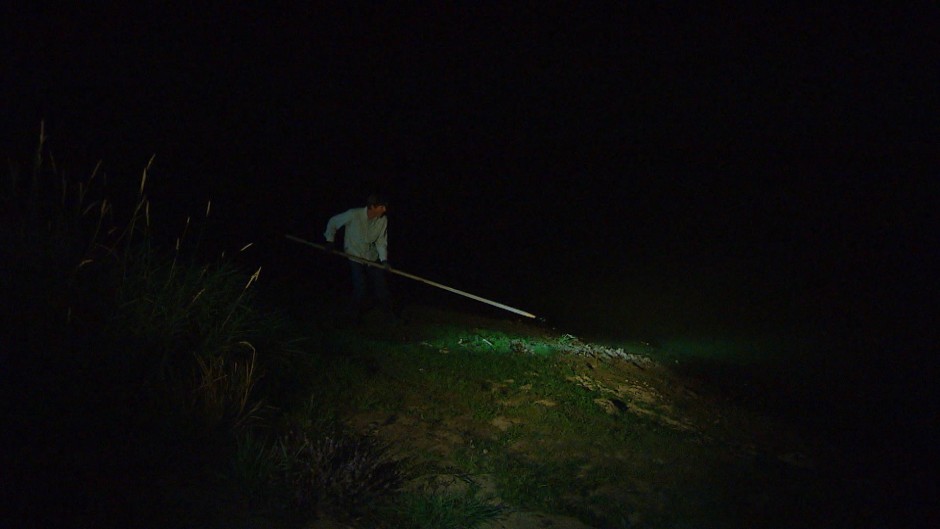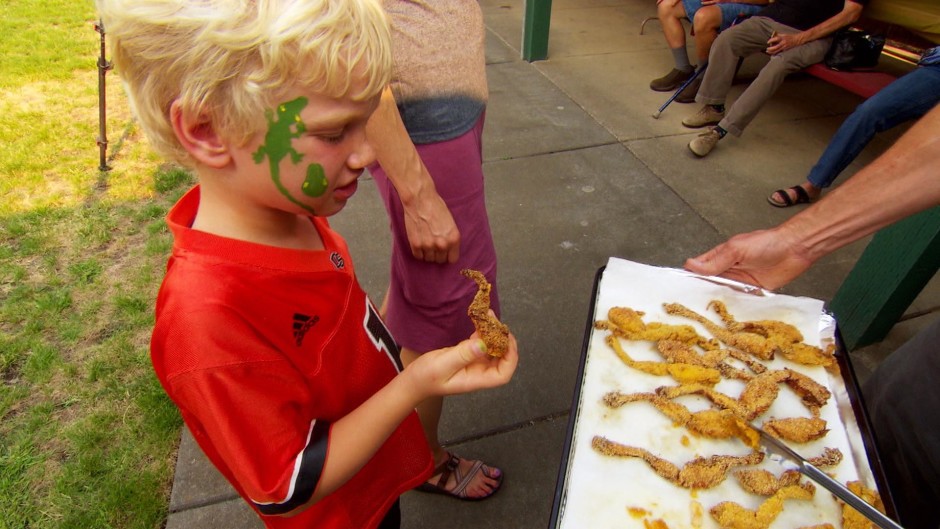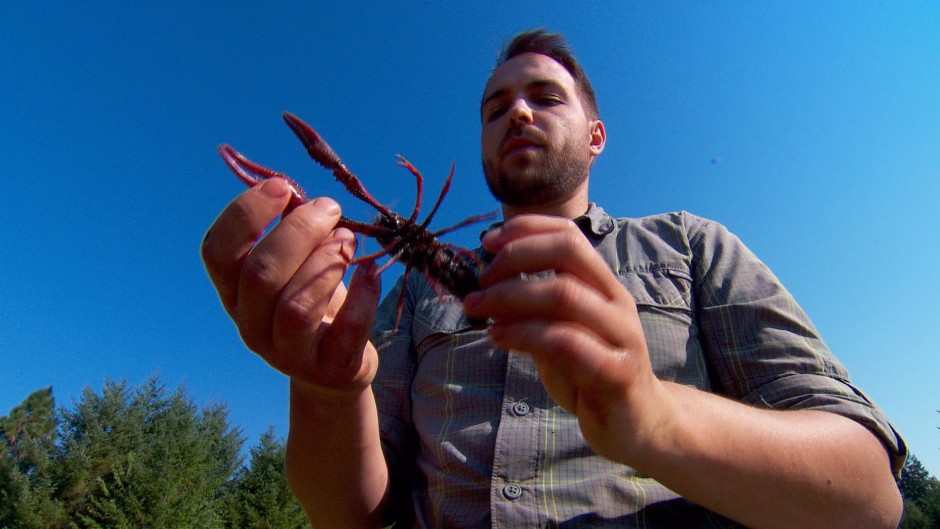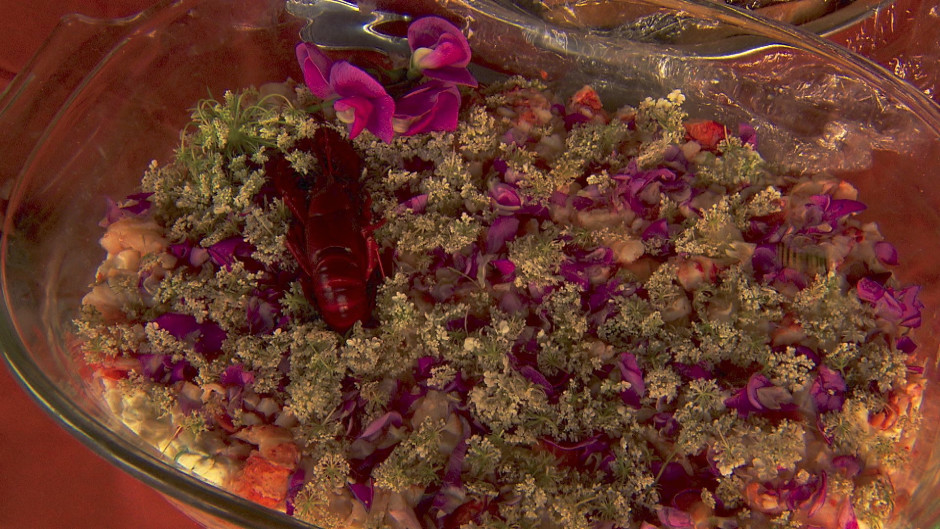Armed with a flashlight and a spear under the cover of night, Tom Kaye creeps toward his targets on the edge of a pond near Corvallis, Oregon.
“There’s the one we’re going to go after first,” he said. “I can see some twinkling eyes and then there’s several all the way up the shore.”
Invasive American bullfrogs have taken over the pond, and that’s bad news for native species.
“Bullfrogs are a major predator in aquatic systems,” Kaye said. “They eat basically everything they can stuff into their mouths: fish, other frogs, small birds, ducklings, goslings. They’ll eat rodents.”
Kaye wants to turn the tables on these hungry predators – by putting them on the dinner table. But he has to catch them first. His plan is to fry up a big batch of frog legs.

Tom Kaye hunts for invasive frogs in a pond near Corvallis, Oregon. Photo by Nick Fisher/OPB
“The way I prepare them is you take the frog leg and you coat it in egg yolk and dip it in cornmeal and fry it in cornmeal and then lightly fry it in peanut oil and it makes a really nice, easy to eat and delicious meal,” he said.
‘Eradication by Mastication’
Kaye directs the Institute for Applied Ecology in Corvallis, Oregon. The group restores native habitats, and that means facing the daunting task of controlling invasive species. They draw people to their cause by showcasing invasives you can eat in an annual feast and cooking competition called “Eradication by Mastication.” They even put out a cookbook of invasive species recipes called “They’re Cooked: Recipes to Combat Invasive Species”.

A child tries some Cajun-fried bullfrog legs. Photo by Nick Fisher/OPB
Instead of pulled pork, Kaye says, you can have pulled nutria – using the meat from an invasive rodent. Rather than popcorn shrimp, their cookbook has a recipe for popcorn starling – an invasive bird.
“Many invasive species are quite edible – and delicious even,” Kaye said. “There’s an interesting ‘eew’ factor around eating invasive species like nutria or frog legs. It really seems odd to a lot of people, so they’re at the same time repulsed and fascinated.”
Invasive crayfish dip
The institute’s ecologist, Ben Axt, has a great recipe for invasive crayfish dip.
Step one: Head to the nearest river or lake. He traps red swamp crayfish in local ponds near his office.

Ben Axt, an ecologist with the Institute for Applied Ecology, traps invasive crayfish in a pond near Corvallis, Oregon. He steams them and adds the tail meat to a cream cheese dip. Photo by Nick Fisher/OPB
“They’re in most of our major waterways and they’re pushing further and further out all the time,” Axt said. “You can tell it’s red swamp crayfish from the native one because it has these bumps on the claws.”
Invasive crayfish eat fish eggs and edge out native crayfish, Axt said.
They also burrow into the mud and stir up sediment that makes it harder for other species to survive. The good news is they taste like little lobsters.

A bowl of invasive crayfish cream cheese dip. Photo by Nick Fisher/OPB
“These are tasty,” he said, holding up one of the crayfish that he trapped. “I’m going to steam them up and make them into a kind of a crab dip. Should be pretty good.”
Thistle dandelion quiche
If you’re a vegetarian, there are plenty of problem plants you can eat. Jennie Cramer is a botanist with the Institute. She has a way of cooking invasive Canada thistle — a hostile-looking plant with thorny leaves — into a quiche that won’t puncture people’s mouths. It’s easy to find, she says, because it’s such a ubiquitous invader.
“It’s all over the state. It’s all over the country. It’s pretty much all over the Northern hemisphere,” Cramer said. “You’ll find it in places that have been disturbed. Usually there’s been either some development or logging of some kind, maybe a landslide or erosion or grazing.”
Believe it or not, she says thistle can actually be tasty – with the proper cooking method.

Jennie Cramer cuts bull thistle, a thorny plant, near Corvallis, Oregon. Photo by Nick Fisher/OPB
“It does have thorns, but when you boil the leaves the thorns will kind of fade away and then you can cook it in butter, and it will taste really good,” she said. “If you take the stems and peel back the outer layer, the inside is actually pretty tender on the younger parts of the plants. You can eat it like asparagus – raw or cooked.”
At home, she mixes the thistles with dandelion greens, herbs and veggies from her garden to make a quiche.
“I’m masking the wild flavors a little bit on purpose because they are pretty potent, and we want it to taste good as well as be eradicating our invasive species,” she said.
Not really the solution
Even with lots of fun and tasty options, Kaye says eating invasive species isn’t really the solution – but it does get people’s attention.
“We don’t really think we’re going to eat our way out of this problem,” he said. “It’s really an awareness method to bring to the fore the fact that we have these invasive species. Because let’s face it: some of the impacts they’re having are pretty devastating and depressing.”
He’s found sharing a recipe or a meal can make facing the challenge of invasive species a bit more palatable.
Heart-Healthy Crockpot NutriaMakes 4 servings.
The Institute for Applied Ecology shared their recipe for “heart-healthy crockpot nutria” below. As explained by the institute, compared to turkey, chicken and beef, nutria meat “has the highest protein and the lowest fat and cholesterol.” You just need to catch one of these “river rats” first.
2 hind saddle portions of nutria meat
1 small onion, finely chopped
1 tomato, cut into large wedges
2 potatoes, sliced thin
2 carrots, sliced thin
8 Brussels sprouts
1/2 cup white wine
1 cup water
2 Tbsps. chopped garlic
salt and pepper to taste
Optional additions
1 cup demi-glace
1. Layer onion, tomato, potatoes, carrots and Brussels sprouts in crockpot.
2. Season nutria with salt, pepper and garlic and then place nutria over vegetables.
3. Add wine and water.
4. Set crockpot on low and let cook until meat is tender (approximately 1 1/2 hours).
5. Garnish with vegetables and demi-glace.
This report first appeared on EarthFix’s website. EarthFix is a public media project of Oregon Public Broadcasting and Boise State Public Radio, Idaho Public Television, KCTS 9 Seattle, KUOW Puget Sound Public Radio, Northwest Public Radio and Television, Southern Oregon Public Television and the Corporation for Public Broadcasting.
ncG1vNJzZmivp6x7sa7SZ6arn1%2Bjsri%2Fx6isq2ejmLamusKeZrCZnql6tbuMoZylqF2YvK%2FA0aijZqGeq660tdWeZKyolZi2pr%2BMnpitZZFir7a4y5%2BpqJ8%3D